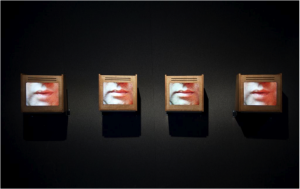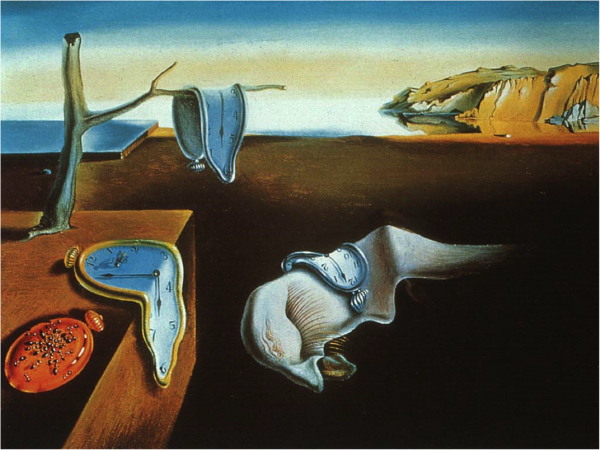Les Demoiselles d’Avignon (The Young Ladies of Avignon, and originally titled The Brothel of Avignon) is a large oil painting created in 1907 by the Spanish artist Pablo Picasso (1881–1973). The work portrays five nude female prostitutes from a brothel on Carrer d’Avinyó in Barcelona. Each figure is depicted in a disconcerting confrontational manner and none are conventionally feminine. The women appear as slightly menacing and rendered with angular and disjointed body shapes. Two are shown with African mask-like faces and three more with faces in the Iberian style of Picasso’s native Spain, giving them a savage aura. In this adaptation of Primitivism and abandonment of perspective in favor of a flat, two-dimensional picture plane, Picasso makes a radical departure from traditional European painting. (Pierre B)
Archives de catégorie : Madrid
Dalí : The Persistence of Memory
Salvador Dalí was a Spanish painter who was born on 11th of May 1904 and who died on 23rd of January 1989. He is part of the surrealistic movement, surrealism is a cultural movement who began in the early 1920s.
Dalí painted The Persistence of Memory, one of his most recognizable works, in 1931. First shown at the Julien Levy Gallery in 1932, the painting has been in the collection of the Museum of Modern Art in New York City since 1934.
This painting represents pocket watches which melt like cheeses. He painted it to represent his fear of death, because melting watches represent the fall of time. In the middle, we can see a strange creature which looks dead.
When we looked at this painting for the first time, we thought of the global warming, because the landscape is a desert land, and the melting of watches makes us think of the end of the world. (Léo)
Salvador Dali: “Hitler’s Enigma”
Salvador Dali was a famous Spanish painter of the 20th century, and one of the leaders of the surrealism artistic movement. His work is mainly exposed in the Museo de Arte Reina Sofia in Madrid. In my opinion, one of his most representative and famous painting is “Hitler’s Enigma”, which is by the way exposed in this museum.
“Hitler’s Enigma” is an unique painting as it’s full of symbols and above all, very well painted. (Pierre)
Venues
There are four main venues in the Reina sofia museum: the Sabatini building, the Nouvel building, the Palacio de Cristal and the Palacio de Velasquez.
The Sabbatini building:
Founded as the Hospital de San Carlos in the 18th century, the building now takes its name from Francisco Sabatini, the architect in charge of its construction. The hospital was founded at the initiative of King Carlos III of Spain, as part of a series of measures to give Madrid the infrastructure necessary for adequate hygiene and urban order.
The building was left unfinished in 1788, it functioned as a hospital from then until 1965. After some years (1977) it was declared Historical-Artistic monument.
In 1980, Antonio Fernández Alba (Salamanca, 1927) remodelled the building to make it suitable for exhibitions. In 1986 it started to host temporary exhibitions as an art centre, to be transformed a few years later, in 1990, into the museum it is today.
The Nouvel Building:
In 2001, the construction of the Nouvel Bulding began , it was going to be the “shadow” of the main building : the Sabatini building. It expands what the Sabbatini building does, without interfering with its central role. There are two big exhibition spaces, a library and a documentation center, there are also a bookshop, offices, eating areas and two auditoriums.
The Palacio de Cristal:
The Palacio de Cristal is one of the two exhibition venues that Museo Reina Sofía has in Madrid’s largest and best-known city park, Parque del Buen Retiro. It was built by architect Velazquez Bosco in 1887. We have a surprising effect made by a combination of cast iron and glass areas. It was originally made to be a greenhouse. Since 1990, it hosted specific projects by comptempory artists.
(Théo)
Art and Artificial Life
L’exposition « Art & Artifical life » à Madrid:
 Cette exposition présente les réalisation des vainqueur de la compétition « VIDA Art & Artificial life » de la Fundation telefonica qui se tient tous les ans depuis 1999. Tout au long du parcours, nous pouvons voir des bactéries génétiquement modifiées, des robots « bio-inspired » et des néo-organisme qui furent créés dans la collaboration entre des artistes, des scientifiques et des technologues. L’exposition coïncide avec l’anniversaire des 25 ans de la première apparition du terme « Artificial life ». L’exposition à pour but de laisser entrevoir les possibilités de création lors d’une alliance entre l’art, les sciences et les sciences humaines.
Cette exposition présente les réalisation des vainqueur de la compétition « VIDA Art & Artificial life » de la Fundation telefonica qui se tient tous les ans depuis 1999. Tout au long du parcours, nous pouvons voir des bactéries génétiquement modifiées, des robots « bio-inspired » et des néo-organisme qui furent créés dans la collaboration entre des artistes, des scientifiques et des technologues. L’exposition coïncide avec l’anniversaire des 25 ans de la première apparition du terme « Artificial life ». L’exposition à pour but de laisser entrevoir les possibilités de création lors d’une alliance entre l’art, les sciences et les sciences humaines.  Elle crée des connections entre le physique et le virtuel autant qu’entre l’organique et le technologique. L’exposition est divisée en cinq parties: « le code de la vie », « Robotique: contrôle et dysfonctionnement », « systèmes symbiotiques, la vie et communication » et enfin « membranes sensitives ». (Théo)
Elle crée des connections entre le physique et le virtuel autant qu’entre l’organique et le technologique. L’exposition est divisée en cinq parties: « le code de la vie », « Robotique: contrôle et dysfonctionnement », « systèmes symbiotiques, la vie et communication » et enfin « membranes sensitives ». (Théo)
Royal Palace
The Royal Palace: Entry fee: €8.00 without guide; €10.00 with guide. Otherwise known in Spanish as the Palacio Real, the Royal Palace was built during the 18th and 19th centuries, and is a monumental building.
The Royal Palace is maybe the top tourist attraction of Madrid. That is why, you would prefer to get awarded of its interests… The royal Palace, indeed, is the official residence for the Royal family, but today, it is only used for state ceremonies. The rest of the time, it is open to the public: the King Juan Carlo and the Royal Family do not live there, they prefer living in a more modest Palace: “Palacio de la Zarzuela” (on the outside of Madrid). The palace is located on “Calle de Bailén” (Street), in the West of the down-town. It is easily accessible from the Ópera metro station. (Nicolas G)



